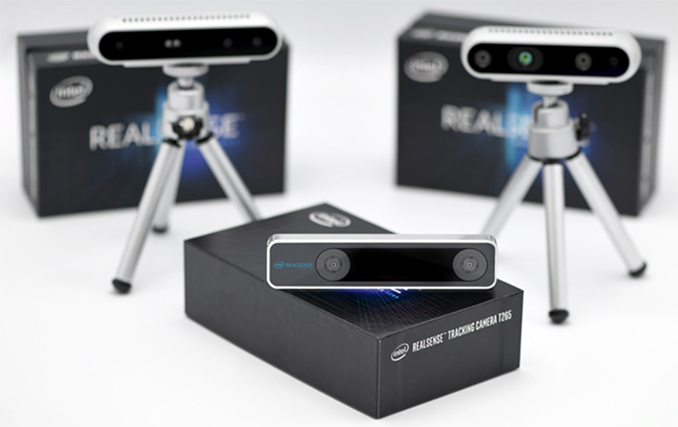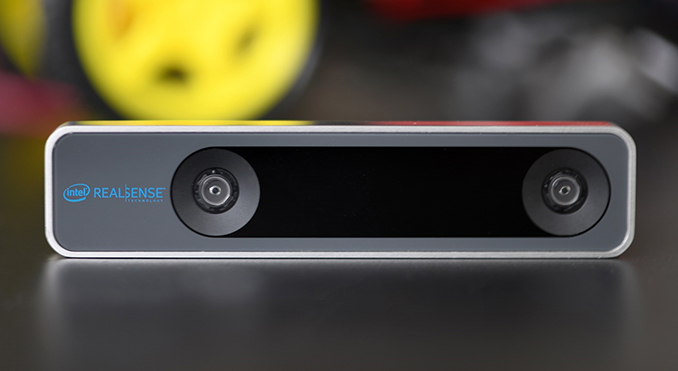Intel's Standalone 6DoF RealSense Tracking Camera T265 with Movidius Inside
by Anton Shilov on January 24, 2019 4:00 PM EST
Intel this week introduced its new RealSense Tracking Camera T265 featuring 6-degrees-of-freedom (6DoF) inside-out tracking. The tracking device is aimed primarily at various self-driving applications like small robots or drones, but can be applied to other devices that benefit from 6DoF inside-out tracking.
The Intel RealSense Tracking Camera T265 is equipped with two fish-eye cameras, each featuring an approximate 170-degree field of view. The data from the cameras is processed by the Intel Movidius Myriad 2 vision processing unit (VPU). Meanwhile, the tracking camera supports Intel’s visual inertial odometry simultaneous localization and mapping (V-SLAM) technology that constructs maps of unfamiliar environments and then repeatedly updates the location of a device within that environment.
The hardware and the V-SLAM algorithm enable applications like robots and drones to accurately navigate within known and unknown surroundings intelligently avoiding obstacles without any need for external sensors (courtesy of 6DoF). Since all processing is done by the Movidius Myriad 2 VPU, the end device can use a very cheap SoC without a lot of compute power, but with a USB 2.0/3.0 interface.
For more advanced applications that need a higher precision and depth, the RealSense Tracking Camera T265 can be paired with the RealSense Depth Camera D400-series.
Intel will begin shipments of the RealSense Tracking Camera T265 on February 28. Each device will cost $199.
Related Reading
- Intel Announces Project Alloy: Untethered Augmented Reality in a VR Headset with RealSense
- Intel and Google Equip Smartphones with 3D Cameras and Computer Vision
- Oculus Quest Announced: A 6DoF Standalone VR Headset
- HTC’s Standalone Vive Focus to Launch Worldwide This Year
Source: Intel











14 Comments
View All Comments
edzieba - Friday, January 25, 2019 - link
Datasheet isn't up yet, just the useless marketing blurb. If this can actually output an unmolested video stream, has a decent framerate and sensor resolution, add supports genlocking like previous realsense cameras, it should make for a very nice DIY mocap camera.edzieba - Friday, January 25, 2019 - link
Looks like the article got hit by an errant CTRL+F: It's the T265 not T625, and it costs $199 not $625.Manch - Monday, January 28, 2019 - link
XBOX TWO featuring KINECT 3 LOLOn a more serious/curious note. Aside from self driving, would this be a good device for mapping a 3D space or to use as a 3D scanner?
mode_13h - Friday, February 1, 2019 - link
No. By itself, stereo is not ideal. Good depth extraction from a stereo camera rig requires textured surfaces and decent lighting.This is good for tracking, because that relies only on being able to extract enough reasonably stable feature points (which probably isn't many). With a wide-FoV camera, that's a much lower bar.